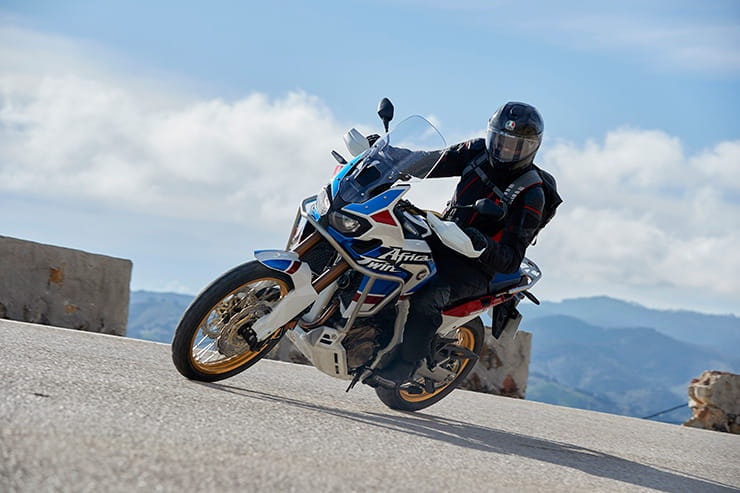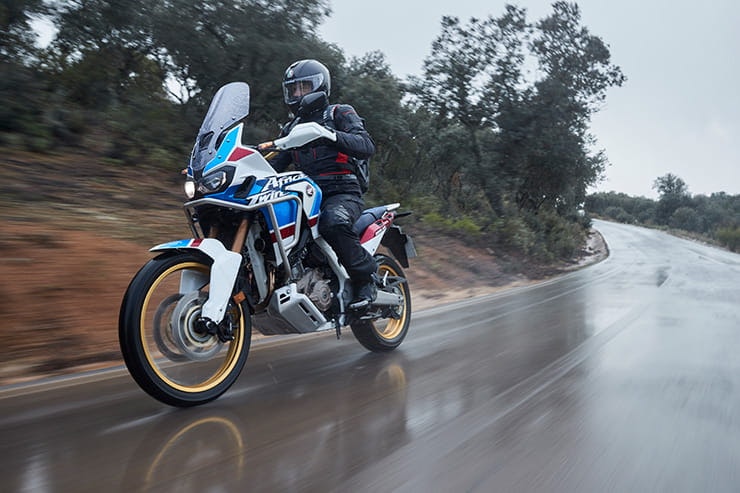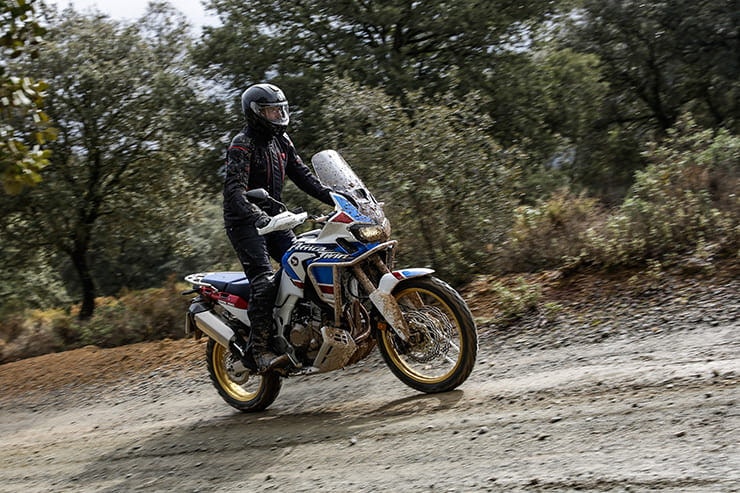Honda Africa Twin Adventure Sports (2018) | First ride & review
By Michael Mann
BikeSocial Managing Editor
09.02.2018
Kit Credits
Helmet
AGV Sport Modular, £549.95 | www.agv.co.uk
Jacket
Dainese D-Cyclone Gore-tex, £679.95 | www.dainese.com
Trousers
Dainese D-Cyclone Gore-tex, £429.95| www.dainese.com
Boots
Dainese D1 Out Gore-tex, £299.95 | www.dainese.com
Gloves
Dainese Universe Gore-tex, £189.95 | www.dainese.com
Rucksack
Dainese D-Elements Back Pack £129.99 | www.dainese.com
The Beast Just Got Beautiful
The logo on the fuel tank highlights the 30th anniversary of the original Africa Twin, XRV650, having made itself known to Europe way back in 1988. The nostalgia of Honda’s foray into ‘dual-sports’ road-biased adventure riding was very much kicking at the press conference introducing the latest incarnation of Honda’s Africa Twin, the ‘Adventure Sports’, as the striking Tricalore paintjob glistened under the lights in homage to the original colours.
Less than 24 hours later and I clambered off the toughest, tallest and most advanced version yet, new for 2018 and just two years after the marques’ rebirth when the CRF1000L was fitted with a 998cc four-valve, parallel twin with its fancy Unicam system and 270-degree crank, rather than the original 742cc V-twin from ‘88. Honda says 25,000 have been sold in Europe since January 2016 and almost half have been equipped with the DCT gearbox. Plus, a further 26,000 on top of that around the rest of the world, popular in the USA, Brazil, Australia and Japan.
Available now from £12,599 or an extra £950 if you fancy the clever DCT version, on paper it lines up among the more off-road focussed adventure/adventure-sports market sandwiched by European rivals from Triumph, KTM and BMW. Other than its huge seat height and tank size, the Honda provides healthy competition for the Triumph Tiger 800 as opposed to the 1200, the KTM 1090 Adventure R instead of the 1290 Super Adventure R and BMW’s new F850GS rather than the King of Motorcycle Sales Charts, the R1200GS. It’s easy to compare price and performance, suspension and seat height or goodies and ground clearance, yet only time (and group tests) will tell if the Honda’s adventurous capability stands it above the others.
The larger capacity versions are often tourers dressed up as adventure bikes bought by riders who don’t want to admit they actually need a comfortable tourer. And for me that’s where the original Africa Twin differed. It didn’t need to copy the GS or GSA because its family tree was already packed full of appropriate DNA.
VIDEO INTRO: Honda Africa Twin Adventure Sports (2018)
Africa Twin goes large and BikeSocial gets an invite to the riding launch.
Despite a flurry of unexpected snow in the hills north of Malaga ahead of the Spain-based press launch the new taller, butcher and well ‘ard Honda was never going to shy away from a weather-related challenge, on or off road.
After all, among its lengthy list of updates and new parts is the revised and longer travel suspension with new compression and rebound settings, which are still adjustable. For me this is the most important upgrade over the 2015 Africa Twin because of its quality with a classy, plush not-to-soft feel particularly at the front via the 45mm Showa USD forks. An increase of 22mm at the front and back leads quite naturally to an overall ground clearance increase of 20mm too up to 270mm but the seat is also higher, by 50mm. That makes it a mighty 920mm, adjustable to 900mm, which could be a deterrent for the shorter or less confident rider though a shorter seat option is available. It is mightily tall but at 6-feet (183cm), I could just about place both feet flat on the ground. The riding position points towards the adventure side and is aided by a flatter seat and a grip position that is higher by 32.5mm and closer to the rider by 6.5mm than the 2015 Africa Twin’s. This adds a little extra comfort both for touring and when off-road, says Honda and I agree. Having covered 130 road miles, I had no stretchy-leg requirements and even off-road, the standing position the bars were in the right place but the instrument panel was a little tricky to read. The 80mm higher screen was a welcome new addition too, on paper. Though in reality it still needs an extra 10mm and should really be adjustable. The VFR1200X has one, as does the X-ADV.
And while I’m on about wish lists, then cruise control would have been a handy addition to bring its electronics in line with its rivals. Test Project Leader, Tanaka-san told me, “It was considered but we felt it was not necessary because it is an adventure model.”
Heated grips are fitted as standard on the new model but the system is the same as what used to be an option on the previous model. This was a bone of contention among owners who had purchased the after-market add-on because even at the maximum setting of ‘5’ for the first 15 minutes, they’re still about as warming as a mouse’s fart. Especially under winter gloves. The location of the heated grip symbol on the instrument panel is a little dubious, right next to the ‘6’ from the rev counter, so for at least half an hour I thought I’d found a bonus heat setting.
The new instrument panel is easier to use and has more numbers to replace the bars. Having named engine modes instead of numbers for the selectable Power, Engine Braking and Torque Control settings is convenient. Yes, it’s an upgrade and yes, it’s better than the old version but there was surely a little extra yen in the budget for a slicker, tricker version to compete with the smart systems on the most recent BMW and KTM. My own reflection became troublesome too and the attached hood looks like an afterthought.
DCT. As easy as ABC.
Like it or not, the Dual-Clutch Transmission (DCT) gearbox is here to stay and tied with the new throttle-by-wire system, together it offers a more precise throttle response and an autoblipping downshift for the four riding modes. Which makes an ace noise - from second down to first particularly - thanks also to the improved exhaust sound. Whether using Drive, any of the three Sport modes or even the manual up and down buttons on the left bar either side of the grip, the system adds an extra 10kg on the standard weight of 243kg plus an extra £950 on the OTR price. Some love it, others don’t and I got to try both the DCT model and manual version on the launch. Even though I’m stickler for the more traditional gearbox and foot-operated change, I am a fan of the DCT because of the options it presents depending on the type of ride or even mood. Drive mode has the least rev-related enthusiasm and will have flicked through the gears quickly while S3 – the sportiest of the three Sport modes – hangs onto the revs for much longer before changing. Otherwise the manual option allows you to control the jerk-free, almost seamless change, popping on the auto-blipping downshift for added audible delight. The change is effortless and with no weight transfer to upset the ride, even mid-corner.
All of which is of course connected to the beautifully tractable, smooth engine. It’s a gem, all except that initial pull in first gear – the torque is ideal for climbing hills or pulling away from the lights/roundabout disguising its sub-100bhp power figure. Does it need any more? Well, if it’s only going to be used on the road then yes, I’d say another 25bhp to bring it closer to the KTM or even R1200GS would be sensible. It’d dominate the class too. Yet off-road where Honda have the Africa Twin Adventure Sports focussed, it simply isn’t necessary. Low-down torque and a super smooth motor are ideal, particularly with the manual gearbox. The throttle-by-wire has smoothed the instant connection a little but it’s still not perfect; a little clumsy and nervous for three-point turns, for example. So, make sure a chum is filming because the £250 from You’ve Been Framed might be useful when you plant the bike in a nearby shop window.
Speaking of climbing hills or using the motorway to get to another hill you’ll be good for over 290 miles from the 24.2 litre fuel tank, which represents an extra 5.4 litres over the standard bike. That range figure is based on my 54.4mpg on the road section of the 130-mile press ride. Despite the extra weight of the fuel, standard fit engine bars, sump guard and bash plate the Honda is still agile enough. The taller riding position is supplemented by the handlebars being re-positioned to be both higher and closer to the rider which makes both touring and standing up for the off-road sections a little more comfortable. The flatter seat and redesigned luggage rack offers practicality for carrying two cases of lager instead of a 6-pack, for instance.
The grunty and bottom-end laden torque of the Adventure Sports separates itself from the Triumph or BMW rivals while the new throttle-by-wire system includes 4 riding modes…with names…Tour, Urban, Gravel or User – for a bespoke set-up. There’s even a range of 7 torque control (traction control to those outside Honda) options compared to 3 on the old model.
Rolling between second and third gear corners with the DCT ‘box set to S3 and the engine mode in Tour, the bike holds onto the revs all the way to the red line. Anything above 4-4,500rpm is where the Africa Twin is at its sportiest with appearance-defying lean angles achievable. The new longer travel suspension makes the abnormalities in southern Spain’s more mountainous roads feel more like the newly relaid Silverstone circuit albeit with a slight lurch forward if hard on the brakes. Stopping 253kg plus rider plus lunch is of minimal concern with ABS on your side just in case.
It’s important to understand the Honda’s personality too. This is not a tourer dressed up as an adventure bike, it’s an out-and-out dirt master, spectacularly well-made and dripping in nostalgia.
Other new bits include a 12v AC charging socket, wider footpegs, redesigned pillion foot peg holders that sit flush, self-cancelling indicators, emergency brake lights and a minor change with the tyres– the standard road tyres are still the tubed Dunlop Trailmax 610W but they’ve been improved for better wet weather grip and are attached to 21” and 18” wheels with stainless steel spokes after the corrosion issues on the outgoing model.
The airbox has been modified to improve the power unit’s mid-range response, as does a lighter balancer shaft weight while the new lithium-ion battery save 2.3kg and last four-times as long, apparently.
OFF-ROAD
Veering off the asphalt and onto the reasonably flat gravel and mud tracks with bonus puddles, the bike needed setting up which is all achievable via the switchgear and instrument panel. The Honda on-site mechanics had replaced the Dunlops with a set of Continental TKC 80 rubber and with Gravel mode set, torque control down to level 1 (I wasn’t feeling brave enough to turn it off yet), G mode enabled to modify the control of the clutch allowing for a more direct drive. It was also recommended that I deactivate the ABS on the rear with the dash-based button adjacent to ‘G’ mode switch.
Yeah, it might take a few minutes to work it all out but rest assured the Honda will now offer the most appropriate settings to conquer the terrain. With DCT initially set to S2, I left Gravel mode to sort itself out allowing me to concentrate on avoiding nasty looking ruts or boulders but after a while I flicked to manual mode and had the bike holding onto the revs in 1st for longer. To build a little off-road confidence I needed to rely on the availability of a surge in power with a quick flick of the throttle instead of waiting for the split-second while the DCT ‘box decided what was best. I felt more in control yet still had super confidence in the machine. After all, it is far more capable than I.
The manual gearbox option provided the manual clutch control I thought I was looking for but by the time I’d covered only a handful of easy-going off-road miles, I wanted the DCT back. I wanted to trust it.
The engine braking took a little getting used to, I found myself interfering with the front brake too much to begin with because I wasn’t feeling the off-throttle slowing but nevertheless the Africa Twin Adventure Sports is a rough and rugged beast that differentiates itself from the standard yet also updated Africa Twin, with its height, suspension and fuel tank capacity.
There’s practicality with the more manly Adventure Sports bike to match many of its rivals but even the upgrades on the standard CRF1000L Africa Twin for 2018 offer an excellent package, 51,000 worldwide can’t be wrong. To further underline that fact, the Africa Twin was the third most popular bike in Europe above 500cc in 2017. With optional extras including a quickshifter (both up and down), high screen and even low seat, and having run one for a year as a long-term loan bike, I can certainly understand its success.
The legendary name lives on and the team at Honda will remain delighted with the development of the 21st century Africa Twin. It has its own personality, doesn’t pretend to do stuff it shouldn’t, is essentially a big CRF250F and is a handsome, purposeful beast. The niggles are just that, slight annoyances rather than massive issues.
The manual gearbox Adventure Sports is hitting dealers right now while the DCT version will land at the end of February. The regular, revamped Africa Twin will arrive in April.
HONDA AFRICA TWIN ADVENTURE SPORTS vs RIVALS
Africa Twin and X-ADV updated for 2018
The base model Honda Africa Twin also gets upgraded for 2018, two years after its introduction. The features can be found throughout the Adventure Sports: 2kg weight saving with the lithium-ion battery, new instrument panel, throttle-by-wire, new riding modes, 7 options of torque control, intake/exhaust changes and a new tyre option - Bridgestone Battlax Adventure A41. It’s also available in four colours: Candy Chromosphere Red, Matt Ballistic Black, Grand Prix Red or the Tricalore. Priced at £11,575 or £12,549 for DCT.
The feet-forward adventure scooter, X-ADV, gets an rpm increase to 7,500rpm, two levels of Torque Control (plus off), a G switch for DCT, a new Candy Chromoshere Red colour and a 35kW option is also available but only at first registration. The highly entertaining twist-and-go 745cc twin cylinder scoot remains a hoot to ride and with a quick flick of the G-button and switch off TC, I was good to move from tarmac road to hard-packed clay-based firetrack. The 17” front and 15” performed very respectably and while 54bhp isn’t going to shred many tyres on tarmac, it’s a smart amount for a little green-laning. Yours for £9,959.
HONDA AFRICA TWIN SPORT ADVENTURE TECHNICAL SPECIFICATION


